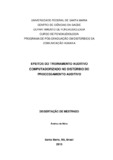| dc.creator | Boaz, Ândrea de Melo | |
| dc.date.accessioned | 2018-09-27T17:43:52Z | |
| dc.date.available | 2018-09-27T17:43:52Z | |
| dc.date.issued | 2015-12-15 | |
| dc.identifier.uri | http://repositorio.ufsm.br/handle/1/14416 | |
| dc.description.abstract | This research aimed to verify the effects of computerized auditory training (CAT) through the use of software in students, age between 7 and 8 years old and 11 months, with APD with and without alteration of speech using behavioral measures, electrophysiological, psychoacoustics and its correlations. The sample was composed of 14 children who have gone through a basic audiometric evaluation subsequently conducted the auditory process-AP behavioral tests (Random Gap Detection Test–RGDT, Pediatric Speech Intelligibility-PSI e Teste Dicótico Não Verbal-TDNV) and Auditory Evoked Potential Long Latency (LLAEP-P300) and the Phonological Evaluation of the Child. In addition to Scale of Auditory Behaviors–SAB administered to parents. After, were divided into two groups: G1 - children with APD and typical phonological acquisition and G2 - children with APD and acquisition of atypical speech, all received 12 CAT sessions held twice a week. Two weeks after completion of therapy intervention, there were again evaluated by behavioral assessments, electrophysiological and SAB scale. For data analysis, we used the McNemar test for verification of categorical variables, Mann-Whitney test for analysis of numeric values between groups, Wilcoxon test to compare the pre- and post-CAT, and the level of significance of 5% (p <0.05). In addition to analysis of the scores obtained on the scale SAB used the Spearman correlation test. This dissertation is structured in the alternative model, which includes introduction, literature review, general methodology, followed by two articles, general discussion that integrates the results of both articles, conclusion, bibliographic references and annexes. According to the obtained results, it can be concluded that the CAT was effective in improving the gnosis auditory processes related to behavioral tests of auditory processing (RGDT and TDNV) in schoolchildren from seven to eight years and eleven months diagnosed with APD, with the acquisition of typical and atypical speech. It was also observed, biological modifications through latency measures of the waves LLAEP. These findings show the effect of the plasticity of the central nervous system after therapeutic intervention. In addition, there were functional changes seen by SAB scale. | eng |
| dc.description.sponsorship | Coordenação de Aperfeiçoamento de Pessoal de Nível Superior - CAPES | por |
| dc.language | por | por |
| dc.publisher | Universidade Federal de Santa Maria | por |
| dc.rights | Attribution-NonCommercial-NoDerivatives 4.0 International | * |
| dc.rights.uri | http://creativecommons.org/licenses/by-nc-nd/4.0/ | * |
| dc.subject | Percepção auditiva | por |
| dc.subject | Criança | por |
| dc.subject | Transtornos de articulação | por |
| dc.subject | Estimulação acústica | por |
| dc.subject | Software | por |
| dc.subject | Auditory perception | eng |
| dc.subject | Child | eng |
| dc.subject | Articulation disorders | eng |
| dc.subject | Acoustic stimulation | eng |
| dc.subject | Software | eng |
| dc.title | Efeitos do treinamento auditivo computadorizado no distúrbio do processamento auditivo | por |
| dc.title.alternative | Effects of computerized auditory training on auditory processing disorder | eng |
| dc.type | Dissertação | por |
| dc.description.resumo | Esta pesquisa teve como objetivo geral verificar os efeitos do Treinamento Auditivo Computadorizado (TAC) por meio do uso de software em escolares, de 7 anos a 8 anos e 11 meses, com distúrbio do processamento auditivo (DPA) com sistema fonológico típico e atípico, utilizando medidas comportamentais, eletrofisiológicas, subjetivas e suas correlações. A amostra foi composta por 14 crianças que passaram por uma avaliação audiométrica básica e testes comportamentais do processamento auditivo-PA (Teste de Detecção de Intervalo Aleatório-RGDT, Teste de Inteligibilidade Pediátrica-PSI e Teste Dicótico Não Verbal-TDNV). Após para composição dos grupos, realizou-se a Avaliação Fonológica da Criança. Os outros procedimentos de avaliação foram: Potencial Evocado Auditivo de Longa Latência (PEALL) e Escala de Funcionamento Auditivo-SAB. Depois, foram distribuídos em dois grupos: G1 – sete crianças com DPA e aquisição fonológica típica e G2 – sete crianças com DPA e aquisição de fala atípica, todos receberam 12 sessões de TAC realizadas duas vezes por semana. Duas semanas após o término do TAC, foram realizadas novamente as avaliações comportamentais, eletrofisiológica e escala SAB. Para análise dos resultados, utilizaram-se o teste McNemar para verificação das variáveis categóricas, teste de Mann-Whitney para análise de valores numéricos entre os grupos, teste de Wilcoxon para comparação entre as avaliações pré e pós-TAC, sendo o nível de significância de 5% (p<0,05). Adicionalmente, para análise entre os escores obtidos na escala SAB e o desempenho nas avaliações comportamentais e eletrofisiológicas utilizou-se o teste de correlação de Spearman. Esta dissertação está estruturada no modelo alternativo, o qual inclui introdução, revisão de literatura, metodologia geral, seguida de dois artigos científicos, discussão geral que integra os resultados de ambos os artigos, conclusão, referências bibliográficas e anexos. Conforme os resultados encontrados, pode-se concluir que TAC mostrou-se eficaz para melhorar os processos gnósicos auditivos relacionados aos testes comportamentais do PA (RGDT e TDNV) em escolares diagnosticados com DPA, apresentando aquisição de fala típica e atípica, do presente estudo. Observaram-se também, modificações biológicas por meio das medidas de latência das ondas do PEALL. Tais achados mostram o efeito da plasticidade no sistema nervoso central após intervenção terapêutica. Além disso, houve mudanças funcionais verificadas pela escala SAB. | por |
| dc.contributor.advisor1 | Biaggio, Eliara Pinto Vieira | |
| dc.contributor.advisor1Lattes | http://lattes.cnpq.br/6091731551273820 | por |
| dc.contributor.referee1 | Costa, Maristela Julio | |
| dc.contributor.referee1Lattes | http://lattes.cnpq.br/5004340831068086 | por |
| dc.creator.Lattes | http://lattes.cnpq.br/0178741555759530 | por |
| dc.publisher.country | Brasil | por |
| dc.publisher.department | Fonoaudiologia | por |
| dc.publisher.initials | UFSM | por |
| dc.publisher.program | Programa de Pós-Graduação em Distúrbios da Comunicação Humana | por |
| dc.subject.cnpq | CNPQ::CIENCIAS DA SAUDE::FONOAUDIOLOGIA | por |
| dc.publisher.unidade | Centro de Ciências da Saúde | por |



